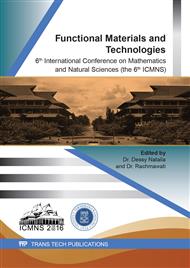p.40
p.47
p.55
p.65
p.71
p.80
p.86
p.92
p.99
Biosorbent from Chinese Cabbage (Brassica pekinensia L.) for Phenol Contaminated Waste Water Treatment
Abstract:
Water pollution is one of the most common problem in industrialized society owing to increase in manufacturing process. Phenol is one of the water pollutant subsequently released into the waste water in manufacturing papers, paints, textile and plastics. Phenol caused serious health effect if in contact with human hence removal of this substance from waste water is crucial. Using bio sorbent in adsorption of phenol offered a green and cheap method for phenol removal particularly in Bandung area where supply of bio sorbent from agricultural waste are abundant. Biomass from Chinese cabbage (Brassica Pekinensis L.) contains cellulose, hemicellulose and lignin, among other substances that present in smaller amount. Dried stems were blended and filtered through 140 mesh and washed with ethanol to provide biosorbent. Modification was carried out by treatment with epichlorohydrin and HCl. Biosorbents were characterized using FTIR, SEM and BET analysis. Adsorption study was carried out according to the following parameters: pH range 5-9, contact time 10-80 minutes, mass of biosorbent 0.2-1.1 g and initial concentration of phenol is 10-50 mg/L. Upon adsorption, the concentration of phenol was measured by HPLC analysis at the following parameter: eluent methanol: water 7:3 v/v, flowrate 0.8 mL/minute at 273 nm. Untreated biosorbent showed adsorption capacity 0.097 mg/g whilst treatment with epichlorohydrine and HCl showed a decrease in adsorption capacity of 0.057 mg/g and 0.059 mg/g respectively. The optimum adsorption capacity was obtained at pH 8, 20 minutes contact time, 0.8 g mass of biosorbent and initial phenol concentration of 10 mg/L.
Info:
Periodical:
Pages:
71-79
Citation:
Online since:
July 2019
Authors:
Keywords:
Price:
Сopyright:
© 2019 Trans Tech Publications Ltd. All Rights Reserved
Share:
Citation:


